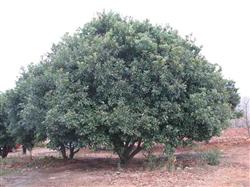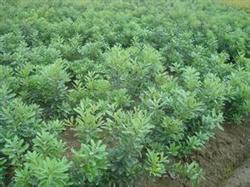Replacement technique of sawing dry height of aged red bayberry

First, cultivate strong rootstocks. 1. Fertilize deeply. At the end of autumn, the whole garden was 20 cm deep, and the plant applied 15 kg of farm manure + 0.25 kg of urea + 0.5 kg of calcium magnesium phosphate fertilizer + 0.25 kg of potassium sulfate. 25 kilograms of lime per mu to neutralize soil acidity and promote root absorption. 2. Saw dry at the right time to promote the germination of rootstocks. After fruit picking (early June), leave 30-70 cm from the ground to cut off the trunk or branches. The high part of the main branch of the old tree leaves only 30-50 cm of the main branch, and the low branch can leave 50-70 cm to cut off the main branch. The saw surface should be smooth, avoid cracking, and protect against bacterial infection, which can be treated with 1:1:10 Bordeaux or 50% carbendazim 400x solution. Before the arrival of high temperature, bandage the saw blade with agricultural film and shade it to prevent sun exposure from causing the saw blade to dry and crack, affecting the germination of hidden buds and the growth of tree crowns. 3. Sprouting shoot management. After more than 30 days, the hidden buds of rootstocks can germinate. When the germinating shoot was 25 cm, the robust and evenly distributed shoot was selected as the new rootstock culture. There are 3-4 branches with the trunk as the rootstock and 2-3 branches with the main branch as the rootstock. The rest of the germinating branches can be temporarily retained as auxiliary branches, and their growth can be controlled by pulling branches, holding branches or twisting shoots during the growing period, so as not to affect the growth potential of the selected shoots. After 5-6 months of culture, the stem diameter can reach more than 2.5 cm. During this period, high temperature, high humidity and frequent occurrence of diseases and insect pests should be timely sprayed to control diseases and insect pests. Methyl topiramate 1000 times solution + 20% isocarbophos solution was selected. Second, timely high grafting. 1. Grafting period. In general, high pick-up can be carried out from late January to early March in a normal year. The survival rate of grafting in sunny days with higher temperature was higher. Avoid operating in windy, cloudy days and low temperatures. 2. Grafting method. Selection and storage of ⑴ scion: one-year-old summer and autumn shoots with full bud eyes and stem diameter of 0. 6-0. 8cm were selected as scions from the middle and upper part of the high-yield crown without diseases and insect pests. It is better to pick and pick the scion. If the mother tree is far away from the garden, the scion can be stored in the refrigerator. The temperature should be controlled at 5 ℃ and the time should be controlled at about 5 days. ⑵ grafting method: the grafting method is used, the scion can be cut into 5-6 cm long branches, the length of the cutting surface is 3-4 cm, the back is 45 degrees slope, and there should be 2-4 full bud eyes above the cutting surface. The germinating branches are cut flat with 6-10 cm, cut down a plane from the junction of cortex and xylem on the inside or side, with the same length as the long cutting surface of the scion, cut off the cortex of the rootstock and cut off 1 stroke 2, embedded in the scion, aligned with the cambium, tightened with a film with dew buds, put on a common film bag 20 cm long and 10 cm wide, fastened the film bag to the base of the rootstock, and cut a small opening at the top of the film bag to make stomata. Third, management after high pick-up. 1. Management of bagging. The germination of grafted buds was observed at any time after 15 days of high grafting. With the growth of buds, the bagging opening should be enlarged, and the film bag should be removed when the scion shoots grew to 6-10 cm, so as to avoid the hindrance of new shoot growth. 2. Make up in time. The survival rate of bayberry grafting is not high. If the grafted branches can not be selected as main branches or secondary main branches, they should be repaired in time, and the survival rate is poor if they are too late. 3. New tip management. With the growth of new shoots, the germinated shoots of rootstocks which affect the growth of new shoots can be thinned step by step, and after the new shoots mature and avoid high temperature, the bandaged thin film band can be removed to facilitate the growth of new shoots. Some branches are growing vigorously, and the branches are not aging, so they should be supported by pillars to prevent the branches from breaking due to wind and heavy rain. 4. Pest control. The occurrence of diseases and insect pests should be observed frequently to give priority to prevention. The main diseases are anthracnose, gum disease, withered leaf disease, choose methyl thiophanate, chlorothalonil or mancozeb to control. The main pests are red bayberry leaf moth, paulownia inchworm, etc., which can be controlled by 1500 times of thiophanate or 1000 times of phoxim or 80% dichlorvos. 5. Fertilization. 0.3 kg compound fertilizer was applied in May and August in the first year, and topdressing was applied 3 times in the second year, 10 days before spring shoot, summer shoot and autumn shoot respectively, and basal fertilizer was applied at the end of autumn. Urea 0.2 kg + calcium magnesium phosphate 0.5 kg + potassium sulfate 0.2 kg was used for each topdressing. 10 kg farm manure was applied to base fertilizer plants. In the third year, with the increase of the tree crown, we should apply more potash fertilizer, topdressing in late February and late July respectively, using 0.3 kg urea + 0.5 kg calcium magnesium phosphate fertilizer + 0.5 kg potassium sulfate for each topdressing, and 15 kg farm manure for October plants, which can be put into production in the fourth year. The amount of fertilizer should be increased year by year, mainly nitrogen and potassium, and the ratio of nitrogen, phosphorus and potassium is 10.2 and 3-4. 6. Set and trim. The bayberry tree shape after high grafting and replacement can adopt natural happy shape and natural round head shape. The rootstock is the trunk, and three evenly distributed shoots are selected as the main branches; the rootstocks are the main branches, and the new shoots are selected on both sides to form a natural round head crown, and the rest are thinned. The secondary main branch and fruiting branch group were cultivated from the second year. During the growing period, apical growth should be controlled, excessively long lateral branches should be picked in time, branches should be promoted, and cross and overlapping branches should be removed. Through pruning to achieve a clear crown subordinate, balanced growth, ventilation and light, in order to facilitate three-dimensional results. Fourth, to control shoot and promote flower, in order to put into production early, appropriate measures of promoting flower and fruit were applied in the third year. Combined with pruning, weaken the top advantage. Cut off the upright growing branches in each shoot and open the crown; the method of pulling branches is used to ease the growth of branches. In the first ten days of July of the third year, spraying 15% paclobutrazol 300 times solution on the crown can increase the number of flowers, delay the vegetative growth of autumn shoots and increase the fruit setting rate.
- Prev

What about ginkgo fruit drop?
What about ginkgo fruit drop?
- Next

Dongkui Waxberry and nutrient element Zinc
Although zinc is a trace element in plants, if Dongkui red bayberry is deficient in zinc, it will affect its growth. Because zinc has many effects on Dongkui bayberry, such as: first, the role of zinc (1) zinc is related to auxin synthesis in trees. That is to say, when Dongkui bayberry needs to synthesize auxin, there can be no lack of zinc.
Related
- Moge, come on! The staff of the peasant association in the producing area of cantaloupe were frightened when the crowd gathered.
- Causes and Solutions of low Fruit setting rate of Apple
- Symptoms and control measures of passion fruit virus disease
- Fruit growing lesson: how do apple orchards keep high yields?
- Can you build orchards in the mountains? What are the pros and cons?
- How to manage the coloring period of Crisson grape?
- This paper introduces the processing technology of two kinds of fig products.
- How much is a month for retired teachers in rural areas by 2020?
- How can strawberry planting increase sugar content? We should pay attention to management in many aspects.
- What are the cultivation techniques on how to improve the yield of golden fruit?

